You See Me – A Film Review and Narrative from Director Linda J. Brown
By Linda Brown, M.Ed., MFA
About the Film
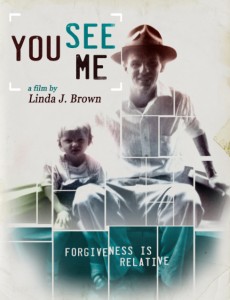 Filmmaker Linda Brown’s father embodied 1960s masculinity. But when a devastating stroke leaves him vulnerable and dependent, Brown decided to confront the silence surrounding his troubled and violent past by drawing on home movies, family photos and interviews. The result is her 2015 documentary You See Me. What begins as an intimate, autobiographical story about loss and grief evolves into a universal look at the impact of trauma, the tragedy of mental illness and the meaning of family. Throughout the film Brown raises questions like: Why is it important to make sense of one’s parents? What is to be gained from understanding them, especially in late life? How do we lay to rest a family member who has repeatedly hurt others and caused pain? Her search for answers leads her to discover the danger of taking unresolved grief to our graves, and the consequences of neglecting to confront and treat deep rooted emotional pain – for our children, and our children’s children. As we witness a vital new bond form between mother and daughter across the generational divide, far reaching truths, about patterns of behavior, family dynamics and gender roles are observed. Behind the images of happiness projected through home movies is a more complex, nuanced story about the legacy of unarticulated pain, secrets and lies. Brown’s work documents the essence of the human condition and seeks to face the past with courage in order to change the future.
Filmmaker Linda Brown’s father embodied 1960s masculinity. But when a devastating stroke leaves him vulnerable and dependent, Brown decided to confront the silence surrounding his troubled and violent past by drawing on home movies, family photos and interviews. The result is her 2015 documentary You See Me. What begins as an intimate, autobiographical story about loss and grief evolves into a universal look at the impact of trauma, the tragedy of mental illness and the meaning of family. Throughout the film Brown raises questions like: Why is it important to make sense of one’s parents? What is to be gained from understanding them, especially in late life? How do we lay to rest a family member who has repeatedly hurt others and caused pain? Her search for answers leads her to discover the danger of taking unresolved grief to our graves, and the consequences of neglecting to confront and treat deep rooted emotional pain – for our children, and our children’s children. As we witness a vital new bond form between mother and daughter across the generational divide, far reaching truths, about patterns of behavior, family dynamics and gender roles are observed. Behind the images of happiness projected through home movies is a more complex, nuanced story about the legacy of unarticulated pain, secrets and lies. Brown’s work documents the essence of the human condition and seeks to face the past with courage in order to change the future.
The Need for a Title
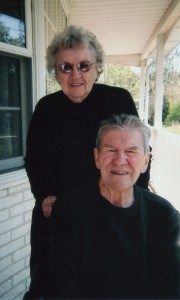
Natalie and Stanley Brown post stroke, Reading, PA, 2004
After a recent screening of my feature documentary, You See Me, which I began when my father Stanley Brown suffered a debilitating stroke, a friend sent me an article he thought related to my film. It discusses the basic human need to be acknowledged and states that in the African Zulu culture when someone greets another they say sawubona which means, “I see you. I see your personality, your humanity, your dignity.” The person greeted answers ngikhona, (“I am here”). Then the exchanges are reversed. 1 In this way, both people feel they have been seen and understood and that their essence has been recognized. The greeting represents the philosophy of Ubuntu, which teaches that through our interaction with our fellow human beings, we discover our own human qualities.2
This was of particular interest to me because finding the right title for my film was a challenge. I remember sharing my frustration with a filmmaker who said, “When you find the right title, believe me, you’ll know.” And they were right; that’s how it happened. It was a phrase uttered by my father while he was preparing to show me his unassisted walk in a physical therapy session. In a slow, feeble, yet determined voice he said, “You see me,” then a long pause, common to stroke patients with apraxia, “walk.” Since my film is about seeing my family, literally and figuratively, through mature and compassionate eyes, I knew it was right.
The Need to See
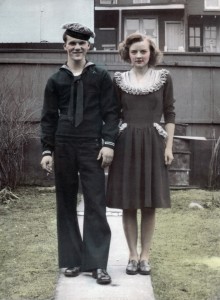
Stanley and Natalie Brown, Reading, PA, 1945
The most common question after a screening is, “Why did you want to make this film?” I needed to understand my father. We were close, but there was something that prevented him from expressing and showing his feelings. He also experienced abrupt mood swings and had anger issues. As a child I found this confusing and hurtful. After my dad had his stroke I began to spend more time with my parents. It seemed like the perfect opportunity to delve into his obscure and painful childhood and gain access to his guarded emotions. While I was beginning to put the pieces of his life together, his health, both mental and physical, was rapidly declining. Then, suddenly and inexplicably, he died. I was left with these facts and needed to make sense of them. Putting them into a meaningful story is the way I came to understand my dad, my family and ultimately myself. For me this journey was enlightening and healing. I now see both parents differently, separate from me, with their own stories, virtues and flaws. They are products of their histories, wrestling with their demons, just like me. It helped me rehabilitate the memory of my father and connect with my mother in a new an unexpected way.
For a number of years I resisted hiring an editor, believing no one outside my family could understand the complications and complexities in our dynamics. How could a stranger reveal what we had spent a lifetime, consciously or unconsciously, conspiring to conceal? But I was mistaken. My closeness actually clouded my perception and objectivity. Trying to serve as both observer of, and character in, my own narrative was unproductive. Nels Bangerter, editor of You See Me, is a former USC’s School of Cinematic Arts student and wise beyond his years. It was Nels who encouraged me to take aesthetic and personal risks and challenged me to grow as a filmmaker.
The Need to be Seen
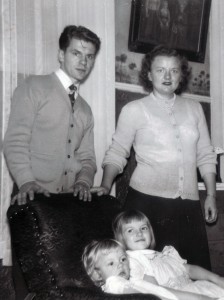
Stanley, Natalie, Linda and Susan Brown, Reading, PA,1953
There’s a line of narration in You See Me where I describe my father’s personality as big, bold and bossy. Yet, behind that masculine veneer, was a broken and wounded man. His traumatic childhood, the neglect by his mother and abandonment by his biological father effected his development from adolescence, through adulthood and into his senior years. It impacted his ability to form and maintain healthy relationships, leaving him feeling unworthy of love and filled with shame. His violence, jealousy, anger and depression were, I believe, adaptive survival skills. He always struggled with his feelings but as a young, strong and healthy man, he was able to suppress them and throw himself into his work. As he grew old, weak and ill, he could no longer avoid or hide them. They surfaced and became part of his reality.
For me the scene that poignantly and painfully illustrates my father’s need to be seen features grainy video of my 80-year-old father visiting his 100-year-old mother, both in wheelchairs. As he reaches for her, she slaps his hand away and spits on him. My mother, Natalie warns him to move away so she can’t spit on him again and he replies, “I don’t care, I don’t care.”
How ironic that I spent years as a filmmaker exploring my father’s inability to express his feelings only to discover, posthumously a lost family video where he turns the camera on himself, faces it directly, and does just that. For over an hour he talked about his love for his wife, children and grandchildren. He recalled endearing stories from vacations and gatherings and even mentioned that one day after he’s not around maybe we’ll find this recording.
The Need to Be
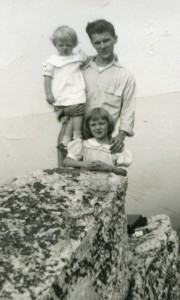
Linda, Stanley and Susan Brown, Hawk Mountain Sanctuary, Kempton, PA, 1953
What is most surprising to me is how much I have learned and continue to learn from You See Me. Today I have more compassion for my father and admiration for my mother than I had before the film. My relationship with my mother has flourished in ways I never imagined. I’m still practicing the art of asking for help and guidance. This simple act has taught me I’m valued not only for my accomplishments but also my humanity. As I travel with the film, I’m encouraged by the intimate stories audience members share. Although topics discussed range from family secrets, mental health, loss, forgiveness, to caring for ill or aging loved ones, there is a common thread: a desire to see and be seen with respect and dignity; with the hope of gaining insight and understanding from life’s challenges and difficulties. In other words, in true ubuntu, spirit, it is “through our interaction with fellow human beings, we discover our own human qualities.”
Student Perspective: Crossing the Barriers of Difficult Conversations – Interview with Linda Brown
By Emilly Marshall, SPT –
Brown, who is an Associate Professor at USC’s School of Cinematic Arts, sees her film as a teaching tool for rehabilitation disciplines “understanding patients between the lines and getting better at knowing their stories.” She has experience with a variety of healthcare providers, but tells us that, in relation to her father’s physical therapist, one of the greatest values a clinician can bring is to serve as a friend and confidant that patients sometimes can’t find in their own family or caregivers; someone who can be realistic and “honest, without unraveling the hope; keeping the hope.” It makes for a wonderful experience when a physical therapist allows him or herself to become vulnerable and enter the “patient’s” territory by listening to the stories, supporting the family, and being attentive to the details of what makes the patients who they are. This applies to the entire team that is involved in the rehabilitation process. Not only can a healthcare provider make a difference during medical problems, but also when a family is trying to cope and asks difficult questions.
You See Me also provides commentary about caregivers. What happens when spouses care for each other or when children have to care for their parents? While she was making the film Brown came to “[see] her parents as separate [from her], even flawed.” This feeling is not uncommon among children caregiving for their parents. She suggests that we “may never really know who our parents are until roles reverse and we are now their caregivers. We will see them in a different light and with their own stories. While this won’t change who they are in the present, it may change our perspective of who we thought they were in the past.” This truth applies to all caregivers: “The person you are caring for might be someone new, yet they still need and want all of your love and attention as they did before the change in their health.”
By focusing on the stroke survivor through the lens of family history and relationship, You See Me serves as a poignant reminder to appreciate the individual challenges in a person’s life that may have been present prior to the current diagnosis. Often existing silently in the background, those issues can interfere with recovery and remain unresolved barriers in rehabilitation. According to Brown, she experienced feelings of isolation from her father. She also felt as though only her family had secrets. Ultimately, the filmmaker came to realize that she was not the only individual facing issues. She tells us, “If we can walk in that fear, we realize we’re not alone”. She emphasizes that “giving the patients and caregivers the time and opportunity to deal with those personal and family challenges is as much a rehabilitation therapy as any physical exercise. Those opportunities include providing contact information for peer groups, communication with other providers, and never forgetting that caregivers and patients just want their lives to remain, according to Brown, “whole and valuable.” She feels strongly that addressing the mental as well as the physical health of patients and caregivers can be the foundation for the success of overall recovery, and encourages the medical professional to seek to understand the patient both in the context of his or her life, and through the perspective of the patient’s family.
Resources
Brown, L. Personal website. http://lindabrownfilmmaker.com. Accessed March 23, 2016.
You See Me Facebook page. https://www.facebook.com/YouSeeMeFilm. Published 2013. Accessed March 23, 2016.
You See Me film website. http://youseememovie.com/. Published 2013. Accessed March 23, 2016.
You See Me (2015). International Movie Database. http://www.imdb.com/title/tt2877530/. Accessed March 23, 2016.
References
- Pearson G. African famine: “I See You.” The Huffington Post. http://www.huffingtonpost.ca/glen-pearson/africa-famine_b_922063.html. Published August 9, 2011.
- Suze Manda D. Ubuntu philosophy as an African philosophy for peace.http://www.africafiles.org/article.asp?ID=20359. Published March 14, 2009.
- Suze Manda D. Ubuntu philosophy as an African philosophy for peace.http://www.africafiles.org/article.asp?ID=20359. Published March 14, 2009.



 Member since 2019 | JM14274
Member since 2019 | JM14274


NO COMMENT